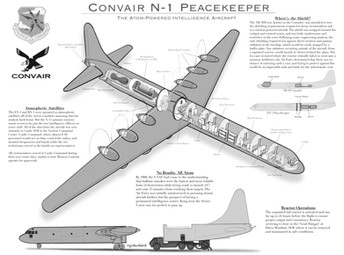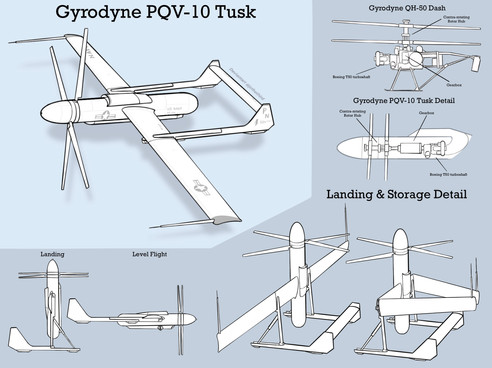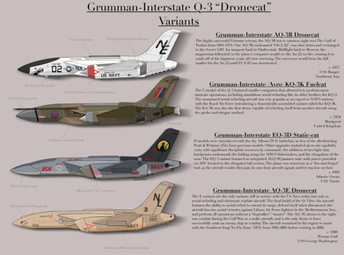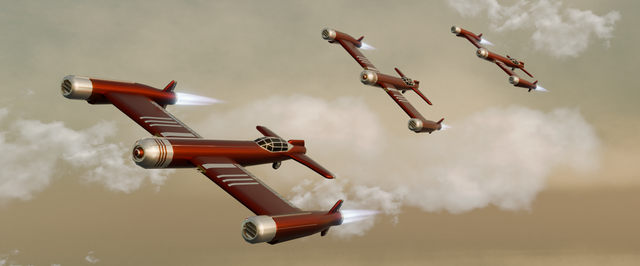HOME | DD
 jcthethird — Republic MF-99 Thunderguard
jcthethird — Republic MF-99 Thunderguard

#aircraft #airplane #trapeze #whatif #fighteraircraft #whif #aircraftdesign
Published: 2021-07-04 05:12:21 +0000 UTC; Views: 10112; Favourites: 87; Downloads: 31
Redirect to original
Description
''NOTE:''' This is a what-if aircraft, with what-if scenarios related to them. Sorry for the delays in posting, been rather busy.==Republic MF-99 Thunderguard ==
*Designer: Republic Aviation
*First Flight: 1953 (YF-99)
*Introduced: 1955
*Status: Retired (1992)
*Total Built: 640
*Operators: United States Air Force
In the middle of World War II, the United States began investing into longer-ranged bombers for the possibility of having to strike Japan from Oceania of Southeast Asia. At the time the Douglas MB-19 was capable of making such flights, but operated at lower altitudes, making it too vulnerable to risk given the risk of losing crews in the middle of the Pacific Ocean where rescue was virtually impossible. But with the development of the B-36 Peacemaker, the USAAF failed to see a problem that plagued them before. With previous trapeze-fighter escorts, the problem was the “limiting factor”. The MP-42B and MP-42C (1941) was limited by fuel while running its engines on idle (6 hours of flight time for the B and 8 for the C), the MP-46 was limited by oxygen supplies, and the MP-55 by thermal endurance. The MP-60 supposedly fixed the issues of its predecessors, perfect for the MB-29. But the MB-36 would bring about a new limiting factor: pilot endurance.
Shortly after the first MB-36 began testing, the problem reared its head. An unidentified pilot, who was on their 3rd mission in a week, performing a 20 hour flight that required full attention for the duration of it, sitting in a cockpit with a leak to the outside high-altitude, and on a liquid diet constantly to prevent solid waste in flight, suffered a panic attack at hour 13 in a 20 hour patrol trial flight. He detached his MP-46 and, despite being 1000 miles from a possible landing site and with only 140 miles, and began attempting to head to Hawaii, the next closest airbase. His wingman detached and gave chase, eventually calming the fighter pilot and returning to the MB-36 to abort the mission and return to base.
The new long-range bombers would need their escorts, and pilots were not going to be capable of flying with them for the duration of the fight. To make it worse, the B-52 was going to be even harder, with the potential of flying up to 20 hours one way, and even further when aerial-refueled. A solution was needed, and fast. Republic Aviation, who was manufacturing the MF-84C and the MF-84F for the role, was tasked with the role of fixing the problem. At the time, Boeing was using MC-97 aircraft to swap the F-84 jets with deployed ones on the MB-36 mid-flight. But this took precious resources, and more pilots to be on constant alert. In 1950, the US proposed a plan for what would eventually become Operation Chrome Dome, where USAF aircraft would patrol the Arctic Circle in readiness for a nuclear war, totaling up to 24 hours (if the unflown B-52 was as fast as it promised it was). The originally planned solution, where multiple pilots in a side-by-side configuration were allotted a reclining ejector seat, was already looking unable to meet this demand.
It was thanks to the British that Republic would find its answer. The Royal Navy’s Fleet Air Arm began testing its newest fighter, the de Havilland Sea Vixen, a twin-seat defense fighter armed with a powerful air-to-air radar. What made the aircraft interesting was its use of an asymmetrical cockpit configuration, where the pilot sat as he normally would, but the radar officer sat deeper in the fuselage, with no conventional bubble canopy as the pilot next to him. Using this as an example, Republic redesigned the arrangement of their aircraft, influenced heavily by their British ally.
The XF-99 design called for larger fighter jet that was modified with a twin seat tandem cockpit design, but was intentionally off-kilter to the right. On the left side was a small room, partially recessed into the fuselage to minimize drag. The room, called the bivouac cell, and featured living amenities that made flights more comfortable and easier to deal with. Among these included a symmetrical cot to lie down on, where the beds had pillows at each end and crews slept in opposing directions to each other (crews would cover their pillows prior to the other taking their time), a commode/in-flight toilet with a vacuum cover, solid foods, and entertainment. “Dorms”, as they were often called, featured record players, books/magazines, special cooking hardware, and tape recordings (a strange first at the time) of radio shows. Crews that were in the bivouac cell were often referred to as DJs, as they could broadcast their music to the other crewmember to help maintain their wellbeing and their demeanor as well. As long as the hatches were closed, the bivouac cell could be jettisoned as an ejector seat when above 10,000 feet, and the pilot could eject as well. If the hatches were opened, neither ejector seat would fire for safety reasons.
Other design modifications included modified components for long-endurance flights, such as implementing cover-plates on top of the 4 M39 cannons at the wing roots, which would jettison when ready to use. Other implementations included box launchers for missiles to prevent degradation during long flights, minimizing glass surface area due to thermal stress, and having a backup method of opening and extending landing gear after a 30 hour flight in case the covers were frozen.
===Operational History===
MF-99s entered service in 1955, and were validated for the proposed Operation Chrome Dome missions in 1960. The aircraft ended up carrying AIM-7 Sparrow missiles, as well as the AIM-54 later on (for special operations). During Operation Chrome Dome, the aircraft performed exceptionally, managing to improve pilot attentiveness and, more importantly, their morale. Pilots would determine the perfect scheduling, with some adopting the 5 on-off, others chosing more fluid schedules that changed as the flight went on (more breaks the longer in). No aerial conflict occurred with the Soviets, but Counter-Interception was a common role during this time.
In Vietnam, the MF-99 and MB-52 did participate early on, but ultimately were returned to the Strategic Air Command by 1968 due to the availability of escort fighters in the smaller conflict. The aircraft scored only one victory against a MiG-17 over Hanoi early in the conflict.
The MF-99D featured a redesign in 1970, following the F-105’s supersonic intakes and redoing the cockpit for more accommodations to keep morale high. As the 1980s approached, the MF-99’s usefulness began to decline, mainly as the influx of missiles occured. Despite this, the plane served all the way until the very beginning of the Persian Gulf War, where it was used to escort MB-52s over Central Iraq, albeit rather uselessly.
Related content
Comments: 5

👍: 1 ⏩: 1

👍: 1 ⏩: 1

👍: 0 ⏩: 0

👍: 0 ⏩: 1

👍: 0 ⏩: 0

























